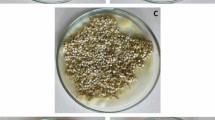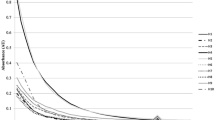Abstract
Although many aspects of scald have been investigated, we are still far away from a general understanding of the disorder. Here, we tried to elucidate the role of the phenolic compounds and their fate during scald development. The study was performed on ‘Granny Smith’ apples. After 5 months in cold storage, scald developed rapidly at room temperature, giving us the opportunity to study unaffected, partly scalded, and fully scalded apple peels. We analyzed the phenolic content, enzyme activity, and gene expression of the flavonoid pathway as well as peroxidase and polyphenol oxidase activity. We demonstrate that scald incidence is mostly dependent on hydroxycinnamic acids, namely, chlorogenic acid and its increased accumulation during scald development, while other phenolic compounds do not seem to be relevant. Expression of genes of the flavonoid pathway was strongly increased during disorder development, whereas a decreased activity of most analyzed flavonoid pathway enzymes was observed. The results presented here help elucidate the role of phenolic content during scald development, which will be useful for future studies of scald development.






Similar content being viewed by others
References
Abbasi NA, Kushad MM, Hafiz IA, Maqbool M (2008) Relationship of superficial scald related fruit maturity with poly phenoloxidase and superoxide dismutase activities in red spur delicious apples. Asian J Chem 20:5986–5996
Abdallah AY, Gil MI, Biasi W, Mitcham EJ (1997) Inhibition of superficial scald in apples by wounding: changes in lipids and phenolics. Postharvest Biol Technol 12:203–212
Ahn T, Paliyath G, Murr DP (2007) Antioxidant enzyme activities in apple varieties and resistance to superficial scald development. Food Res Int 40:1012–1019
Anet EFL (1972) Superficial scald, a functional disorder of stored apples 8. volatile products from autioxidation of alpha-farnesene. J Sci Food Agric 23:763–769
Bain MJ, Mercer F (1963) The submicroscopio cytology of superficial scald, a physiological disease of apples aust. J Biol Sci 16:442–449
Barden CL, Bramlage WJ (1994) Accumulation of antioxidants in apple peel as related to preharvest factors and superficial scald susceptibility of the fruit. J Am Soc Hortic Sci 119:264–269
Bramlage W, Barden C, Watkins C (1993) Comparing potential predicators of scald susceptibility of apples (Malus domestica Borkh.). Acta Hortic 326:237–244
Busatto N, Farneti B, Tadiello A, Vrhovsek U, Cappellin L, Biasioli F, Velasco R, Costa G, Costa F (2014) Target metabolite and gene transcription profiling during the development of superficial scald in apple (Malus x domestica Borkh). BMC Plant Biol 14:1–13
Busatto N, Farneti B, Comisso M, Bianconi M, Iadarola B, Zago E, Ruperti B, Spinelli F, Zanella A, et al (2018) Apple fruit superficial scald resistance mediated by ethylene inhibition is associated with diverse metabolic processes. Plant J 93:270–285
Chang S, Pur Year J, Carney J (1993) ) A simple and efficient method for isolating RNA from pine trees. Plant Mol Biol Rep 11:113–116
Di Guardo M, Tadiello A, Farneti B, Lorenz G, Masuero D, Vrhovsek U, Costa G, Velasco R, Costa F (2013) A Multidisciplinary approach providing new insight into fruit flesh browning physiology in apple (Malus x domestica Borkh.). Plos One 8: e78004
Felicetti DA, Schrader LE (2008) Changes in pigment concentrations associated with the degree of sunburn browning of ‘Fuji’ apple. J Am Soc Hortic Sci 133:27–34
Felicetti DA, Schrader LE (2009) Changes in pigment concentrations associated with sunburn browning of five apple cultivars. II. Phenolics. Plant Sci 176:84–89
Fernandez-Trujillo JP, Nock JF, Kupferman EM, Brown SK, Watkins CB (2003) Peroxidase activity and superficial scald development in apple fruit. J Agric Food Chem 51:7182–7186
Fischer TC, Halbwirth H, Meisel B, Stich K, Forkmann G (2003) Molecular cloning, substrate specificity of the functionally expressed dihydroflavonol 4-reductases from Malus domestica and Pyrus communis cultivars and the consequences for flavonoid metabolism. Arch Biochem Biophys 412:223–230
Golding JB, McGlasson WB, Wyllie SG, Leach DN (1998) Comparison of the peel of scalded and non scalded ‘Granny smith’ and ‘Crofton’ apples. Acta Hortic 464:183–188
Halbwirth H, Fischer TC, Meisel B, Kampan W, Rademacher W, Forkmann G, Treutter D, Costa G, Bazzi C, et al (2002) Biochemical and molecular biological investigations with respect to induction of fire blight resistance in apple and pear by transiently altering the flavonoid metabolism with specific enzyme inhibitors. Acta Hortic 596:513–521
Ju ZG, Bramlage WJ (1999) Phenolics and lipid-soluble antioxidants in fruit cuticle of apples and their antioxidant activities in model systems. Postharvest Biol Technol 16:107–118
Ju ZG, Yuan YB, Liu CL, Zhan SM, Wang MX (1996) Relationships among simple phenol, flavonoid and anthocyanin in apple fruit peel at harvest and scald susceptibility. Postharvest Biol Technol 8:83–93
Lurie S, Watkins CB (2012) Superficial scald, its etiology and control. Postharvest Biol Technol 65:44–60
Mayr U, Batzdorfer R, Treutter D, Feucht W (1994) Surfactant-inducec changes in phenol content of apple leaves and fruit skins. Acta Hortic 381:479–487
Meigh DF, Filmer AAE (1969) Natural skin coating of the apple and its influence on scald in storage III.-α-farnesene. J Sci Food Agr 20:139–139&
Mikulic-Petkovsek M, Slatnar A, Stampar F, Veberic R (2011) Phenolic compounds in apple leaves after infection with apple scab. Biol Plant 55:725–730
Nicolas JJ, Richardforget FC, Goupy PM, Amiot MJ, Aubert SY (1994) Enzymatic browning reactions in apple products. Crit Rev Food Sci Nutr 34:109–157
Passardi F, Cosio C, Penel C, Dunand C (2005) Peroxidases have more functions than a Swiss army knife. Plant Cell Rep 24:255–265
Pesis E, Ben-Arie R, Feygenberg O, Lichter A, Gadiyeva O, Antilofyev I, Uryupina T (2007) A simple pretreatment with low O-2 to alleviate superficial scald in Granny Smith apples. J Sci Food Agr 87:1836–1844
Piretti MV, Gallerani G, Brodnik U (1996) Polyphenol polymerisation involvement in apple superficial scald. Postharvest Biol Technol 8:11–18
Piretti MV, Gallerani G, Pratella GC (1994) Polyphenol fate and superficial scald in apple. Postharvest Biol Technol 4:213–224
Rao MV, Watkins CB, Brown SK, Weeden NF (1998) Active oxygen species metabolism in ‘White Angel’ x ‘Rome Beauty’ apple selections resistant and susceptible to superficial scald. J Am Soc Horticult Sci 123:299–304
Pourcel L, Routaboul J-M, Cheynier V, Lepiniec L, Debeaujon I (2006) Flavonoid oxidation in plants: from biochemical properties to physiological functions. Trends plant sci 12(1):29–36
Rudell DR, Mattheis JR (2009) Superficial scald development and related metabolism is modified by postharvest light irradiation. Postharvest Biol Technol 51:174–182
Shaham Z, Lers A, Lurie S (2003) Effect of heat or 1-methylcyclopropene on antioxidative enzyme activities and antioxidants in apples in relation to superficial scald development. J Am Soc Hortic Sci 128:761–766
Slatnar A, Mikulic-Petkovsek M, Halbwirth H, Stampar F, Stich K, Veberic R (2010) Enzyme activity of the phenylpropanoid pathway as a response to apple scab infection. Ann Appl Biol 156:449–456
Slatnar A, Stampar F, Veberic R (2013) Content of phenolic compounds changes after mechanical injury of apple leaves. Phyton 53:113–124
Wang ZY, Dilley DR (1999) Control of superficial scald of apples by low-oxygen atmospheres. Hortscience 34:1145–1151
Yihui G, Song J, Du L, Vinqvist M, Campbell Palmer L, Fillmore S, Pang X, Zhang Z (2018) Characterization of laccase from apple fruit during postharvest storage and its response to diphenylamine and 1-methylcyclorpopene treatments. Food Chem 253:314–321
Yuri JA, Neira A, Quilodran A, Razmilic I, Motomura Y, Torres C, Palomo I (2010) Sunburn on apples is associated with increases in phenolic compounds and antioxidant activity as a function of the cultivar and areas of the fruit. J Food Agric Environ 8:920–925
Zubini P, Baraldi E, De Santis A, Bertolini P, Mari M (2007) Expression of anti-oxidant enzyme genes in scald-resistant ‘Belfort’ and scald-susceptible ‘Granny Smith’ apples during cold storage. Hortic Sci Biotechnol 82:149–155
Zupan A, Mikulic-Petkovsek M, Slatnar A, Stampar F, Veberic R (2014) Individual phenolic response and peroxidase activity in peel of differently sun-exposed apples in the period favorable for sunburn occurrence. J Plant Physiol 171:1706–1712
Acknowledgements
We would like to acknowledge Renate Paltram for her support in RNA preparation and qRT-PCR studies. This work is part of program Horticulture No. P4-0013-0481 funded by the Slovenian Research Agency (ARRS). H. Halbwirth gratefully acknowledge the financial support from the Austrian Science Fund (FWF) Project number P25399-B16.
Author information
Authors and Affiliations
Contributions
A.C.—experiment execution, extraction and analyses of phenolic content, POX and PPO activity determination, statistical analysis, writing of the manuscript. H.H.—results review and comment (analyzes of enzyme activity and analysis of gene expression), manuscript supervisor. M.M-P.—MS analyses. R.V.—mentor, the experiment initiator and manuscript supervisor. A.S.—determination and analysis of enzyme activity, analysis of gene expression, statistical analysis, manuscript corrections statement.
Corresponding author
Ethics declarations
Conflict of interest
The authors have no conflict of interest to declare.
Additional information
Publisher's Note
Springer Nature remains neutral with regard to jurisdictional claims in published maps and institutional affiliations.
Communicated by Eun Jin Lee, Ph.D.
Rights and permissions
About this article
Cite this article
Cebulj, A., Halbwirth, H., Mikulic-Petkovsek, M. et al. The impact of scald development on phenylpropanoid metabolism based on phenol content, enzyme activity, and gene expression analysis. Hortic. Environ. Biotechnol. 61, 849–858 (2020). https://doi.org/10.1007/s13580-020-00268-0
Received:
Revised:
Accepted:
Published:
Issue Date:
DOI: https://doi.org/10.1007/s13580-020-00268-0




